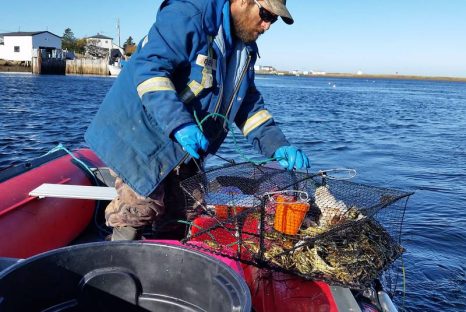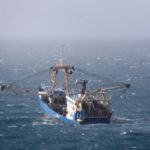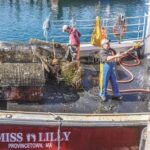Tag Archives: Clams
Commercial fisheries landings increased more than $25 million in value in 2023
 Preliminary numbers for commercial seafood landings in 2023 released today show a strong year for the industry, with commercial fishermen earning $611,277,692 — an increase of $25 million — for 204,684,775 pounds of seafood brought in to state docks. Despite a warming Gulf of Maine, intense storms and the damage to working waterfronts and lower lobster landings, “the Maine seafood industry continues to be a powerful economic engine for our state,” said Governor Janet Mills. Statewide, 93,734,116 pounds of lobsters landed on docks for a $461,371,720 value, an increase of about $72 million. The value represents what is paid at the docks to fishermen, dollars that flow throughout local communities and the state’s overall economy. Stonington is the top port for commercial seafood value this year, bringing in $47.37 million of value, and the second port, behind Portland, for pounds — 13.98 million. more, >>click to read<< 12:54
Preliminary numbers for commercial seafood landings in 2023 released today show a strong year for the industry, with commercial fishermen earning $611,277,692 — an increase of $25 million — for 204,684,775 pounds of seafood brought in to state docks. Despite a warming Gulf of Maine, intense storms and the damage to working waterfronts and lower lobster landings, “the Maine seafood industry continues to be a powerful economic engine for our state,” said Governor Janet Mills. Statewide, 93,734,116 pounds of lobsters landed on docks for a $461,371,720 value, an increase of about $72 million. The value represents what is paid at the docks to fishermen, dollars that flow throughout local communities and the state’s overall economy. Stonington is the top port for commercial seafood value this year, bringing in $47.37 million of value, and the second port, behind Portland, for pounds — 13.98 million. more, >>click to read<< 12:54
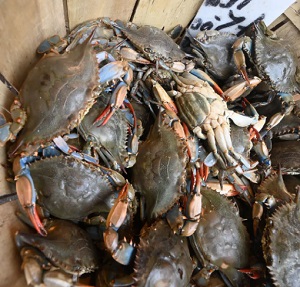
East Hampton fishing for stiffer laws against ‘organized crab crime ring’ stealing bushels of shellfish
Town officials are fishing for even stiffer laws in the war against “organized crab crime rings.” The tougher penalties are needed to turn the tide against “vans full of” out-of-towners bagging “bushels and bushels of shellfish out of Napeague Harbor” and other waterways including Georgica Pond, the town’s attorneys said. “They basically just start taking everything they can grab from the shallows and those two waters: from clams to scallops to conchs, hermit crabs, blue claw crabs. Pretty much grab any size of anything they can in sight,” said Chris Carillo, attorney for the town’s trustees. The night raiders employ a lookout to alert them to Marine Patrol officers and those who are caught don’t carry ID, and because it’s merely a violation, the offenders avoid being fitted for handcuffs, Carillo said. >click to read< 18:41

In New England, “The resource keeps diminishing.” Clammers Dig Through The Pandemic For Fewer Shellfish
In Maine, the largest clam producing state, fishermen produced their lowest haul in more than 90 years at a little more than 1.3 million pounds in 2020. Nationwide totals aren’t compiled yet, but Maine’s haul typically accounts for more than half the U.S. total, and hauls in other clamming states such as Massachusetts, Rhode Island and New York have been trending downward in recent years. “The resource keeps diminishing.” The clamming industry has had to contend with more marine predators of clams such as green crabs and milky ribbon worm in recent years. >click to read< 13:33

‘We won’: Clearwater Seafoods deal gives Mi’kmaq control of lucrative ocean stretch
Early this week, leaders of the Membertou and Miawpukek First Nations, both of which are Mi’kmaq communities, reached an agreement to buy Nova Scotia-based Clearwater Seafoods in a deal worth C$1bn (£580m). Heralded as the “single largest investment in the seafood industry by any Indigenous group in Canada”, the landmark deal comes at a critical moment for Indigenous communities in the region, as tensions remain high over their treatied fishing rights. >click to read< 15:48
Declining biotoxin levels – Some Down East shellfishing areas reopened
On Thursday, the Department of Marine Resources re-opened some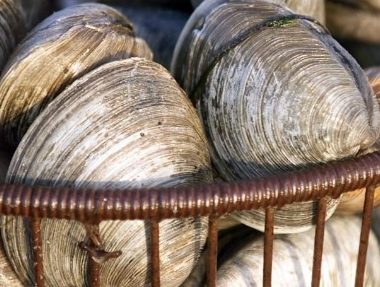 of the coastline between Calais and Cutler for the harvest of clams, mussels and carnivorous snails, and said clamming will be allowed on a portion of the coast between Isle Au Haut to Winter Harbor. Shellfish harvesting on much of the Down East coast remains restricted because of an algae bloom that produces a toxin that can cause amnesic shellfish poisoning, or ASP, in humans. It is unclear if the limited reopening Thursday means the bloom is clearing up or if harvesting bans will be removed in other areas soon. “We can’t speculate, but we continue to test shellfish and phytoplankton along the coast, both inside and outside the impacted areas, and will re-open areas as soon as test results allow,” said Jeff Nichols, a spokesman for the department of Marine Resources. Lifting the emergency restrictions was a relief to clammers who have been kept off the flats for the last two weeks. Read the story here 08:32
of the coastline between Calais and Cutler for the harvest of clams, mussels and carnivorous snails, and said clamming will be allowed on a portion of the coast between Isle Au Haut to Winter Harbor. Shellfish harvesting on much of the Down East coast remains restricted because of an algae bloom that produces a toxin that can cause amnesic shellfish poisoning, or ASP, in humans. It is unclear if the limited reopening Thursday means the bloom is clearing up or if harvesting bans will be removed in other areas soon. “We can’t speculate, but we continue to test shellfish and phytoplankton along the coast, both inside and outside the impacted areas, and will re-open areas as soon as test results allow,” said Jeff Nichols, a spokesman for the department of Marine Resources. Lifting the emergency restrictions was a relief to clammers who have been kept off the flats for the last two weeks. Read the story here 08:32
Toxic algae bloom closes Downeast Maine shellfish industry
 Last week, the Department of Marine Resources issued a recall of mussels, clams and quahogs caught in Downeast Maine after samples tested positive for domoic acid, a biotoxin that causes illness, memory loss, brain damage and possibly death in humans. At the same time, the state banned harvesting for mussels, clams, oysters and carnivorous snails on parts of a wide swath of coastline from Deer Isle to the Canadian border. “A closure for this toxin in Eastern Maine is unprecedented, that is not anything anyone has ever seen,” said Darcie Couture, a Brunswick marine scientist and former head of the state’s marine biotoxin program. “No one on this coast is that experienced with a domoic acid event,” Couture said. “I don’t think it is sinking in how serious this is.” Read the story here 23:07
Last week, the Department of Marine Resources issued a recall of mussels, clams and quahogs caught in Downeast Maine after samples tested positive for domoic acid, a biotoxin that causes illness, memory loss, brain damage and possibly death in humans. At the same time, the state banned harvesting for mussels, clams, oysters and carnivorous snails on parts of a wide swath of coastline from Deer Isle to the Canadian border. “A closure for this toxin in Eastern Maine is unprecedented, that is not anything anyone has ever seen,” said Darcie Couture, a Brunswick marine scientist and former head of the state’s marine biotoxin program. “No one on this coast is that experienced with a domoic acid event,” Couture said. “I don’t think it is sinking in how serious this is.” Read the story here 23:07
China lifts geoduck ban, to Peninsula suppliers’ relief
 China has lifted a five-month ban on live shellfish from U.S. West Coast waters, a move greeted with relief by North Olympic Peninsula producers. The Chinese government announced the ban’s end in a letter Friday, officials said. China imposed the ban in December on the import of clams, oysters, mussels and scallops harvested from Washington, Oregon, Alaska and . Read more here 10:33
China has lifted a five-month ban on live shellfish from U.S. West Coast waters, a move greeted with relief by North Olympic Peninsula producers. The Chinese government announced the ban’s end in a letter Friday, officials said. China imposed the ban in December on the import of clams, oysters, mussels and scallops harvested from Washington, Oregon, Alaska and . Read more here 10:33
National Fisheries Institute – Top Ten List, a Familiar School of Fish
10 Most Popular Make up More than 90% of the Fish Eaten
Washington, DC – September 24, 2012 – From Canned Tuna to Cod the top ten most consumed seafood items by Americans are a very familiar group that feeds a growing market.
The federal government recently reported that the overall seafood volume was 4,650,000,000 pounds. The data also showed American seafood companies exported a record 3.3 billion pounds valued at $5.4 billion.
http://www.aboutseafood.com/press/press-releases/nfi-top-ten-list-familiar-school-fish






